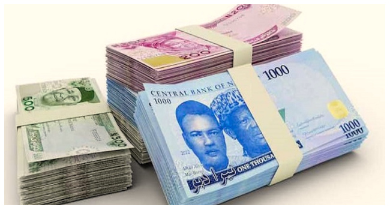
The naira depreciated further on Monday, closing at ₦1,629 per dollar in the Nigerian Foreign Exchange Market (NFEM), despite a $688.8 million intervention by the Central Bank of Nigeria (CBN).
According to data published by the apex bank, the indicative exchange rate rose from ₦1,600/$ on Friday to ₦1,629/$, representing a ₦29 loss for the naira. Similarly, in the parallel market, the naira declined to ₦1,570/$ from ₦1,565/$ recorded last weekend, widening the gap between the official and unofficial markets to ₦59, up from ₦35.
Monthly data further indicates continued weakness in the currency. The naira depreciated by 2.4% at the official Nigerian Autonomous Foreign Exchange Market (NAFEM) window and by 2.6% in the parallel market in March compared to the previous month.
According to Afrinvest’s latest market update, the naira closed March at ₦1,536.82/$ in the NAFEM window and ₦1,530.00/$ in the parallel market, reflecting sustained pressure on the currency across both segments.
In its March macroeconomic report, AIICO Capital noted that demand for foreign exchange remained elevated throughout the month, driven by foreign portfolio investors and domestic corporates. Despite the CBN’s intervention with $688.8 million in dollar sales, the naira depreciated by 2.97% month-on-month, falling from ₦1,492.49/$ at the beginning of March to ₦1,536.82/$ at month-end.
“The naira experienced significant depreciation in March 2025 due to persistent demand pressure in the FX market,” AIICO Capital stated. “Although mid-month liquidity improved following CBN interventions, demand consistently outpaced supply.”
The investment firm also reported that in the final week of March, the naira remained under pressure despite ongoing CBN dollar sales and a slight midweek appreciation. On a quarterly basis, the naira depreciated by 7 basis points in the NFEM window, while external reserves fell by approximately $110 million to $38.31 billion.
Looking ahead, AIICO Capital expects the CBN to continue providing liquidity in the short term to stabilise the naira. However, it cautioned that global risks—such as U.S. tariff actions and potential retaliatory measures—could fuel volatility and capital outflows.
Last week, the naira experienced heightened volatility in the interbank market. Early in the week, it traded relatively steadily between ₦1,525–₦1,535/$, supported by consistent CBN intervention and moderate offshore inflows. However, midweek saw a sharp reversal amid a surge in offshore demand, falling oil prices following OPEC+’s decision to increase supply, and renewed global risk aversion following tariff announcements by former U.S. President Donald Trump.
These factors triggered increased FX demand and constrained supply, pushing the naira as high as ₦1,570/$ in the parallel market. By the end of the week, the naira had declined by 1.97% week-on-week, closing at ₦1,567.02/$, while foreign reserves dropped by $149 million to $38.15 billion.
